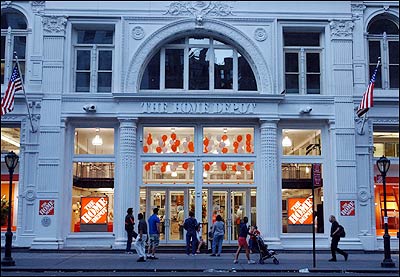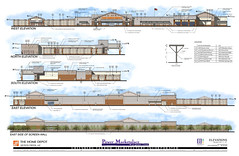Dealing with suburban-scale retail in urban Columbia Heights
(Slightly edited from a post to the Columbia Heights email list, where there is a thread going on about dealing with the amount of traffic likely to be generated by the DC-USA development which will include big box stores such as Target and Bed, Bath & Beyond.)
The challenge in attracting retail and residents to the city is to not do this in a manner that encourages wasteful suburban practices such as driving everywhere. Instead it is imperative that we stand up and defend (and extend) urbanism wherever appropriate and whenever we can.
The issue is to encourage the utilization of alternative modes of getting there, even delivery, to reduce the number of car trips. I am surprised that the number of car trips on 14th Street is actually pretty low, all things considered (H Street NE is close to 25,000 trips/day). Nonetheless, while Dennis is right that congestion in urban areas (unless due to design flaws) is in fact a sign of health and vitality, you don't want to encourage needless driving.
A 1,000 space car garage seems pretty big... if not overkill. The owners of the redeveloped Sears site in Tenleytown (Best Buy, Container Store) have discovered that even during the busiest times (i.e. Saturday afternoon) only 1/2 of the not very many spaces (I think 150) are in use--although that was before the Container Store opened. That site is similar to CH in that it is right on top of a subway entrance. The 50s buses also provide a lot of service as well, and this bus line connects to other heavily travelled lines such as the 90s buses.
 Home Depot in SoHo in New York City. No parking lot, but delivery service is available (plus lots of taxis).
Home Depot in SoHo in New York City. No parking lot, but delivery service is available (plus lots of taxis).The Home Depot in Manhattan is offering delivery service. That should be part of the letter of agreement with Target--in fact, it could be extended to the major tenants in the development (Bed, Bath & Beyond, etc.). Another thing is to figure out how to leverage the customer stream to support other things desired in the neighborhood (such as an interesting and thriving 11th Street commercial district).
And I guess while I understand and respect David's fury, the thing's coming and you gotta deal with it now, to mitigate the potential negatives, and to encourage and strengthen and extend the positives, besides easier access to Michael Graves appliances...
This article by Roberta Gratz, author of Cities: Back from the Edge and The Living City, discusses how suburban retailers are recasting their methods and practices for urban settings: Suburban Retailers Say Hello to Downtown: Home Depot finds a welcoming market in Manhattan. In "Big-box stores squeeze into Big Apple," USA Today also reports on this phenomenon.
It is important to demand urbanism from the big box stores, otherwise we get the cookie cutter, car-centric, parking lot fronted developments like the Brentwood Shopping Center which is a few hundred yards from a subway station, but might as well be off some suburban arterial road miles away from public transit.
 Business as usual from Home Depot.
Business as usual from Home Depot.



0 Comments:
Post a Comment
<< Home